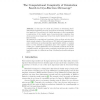Free Online Productivity Tools
i2Speak
i2Symbol
i2OCR
iTex2Img
iWeb2Print
iWeb2Shot
i2Type
iPdf2Split
iPdf2Merge
i2Bopomofo
i2Arabic
i2Style
i2Image
i2PDF
iLatex2Rtf
Sci2ools
ICCS
2004
Springer
2004
Springer
The Computational Complexity of Orientation Search in Cryo-Electron Microscopy
Abstract. In this paper we study the problem of determining threedimensional orientations for noisy projections of randomly oriented identical particles. The problem is of central importance in the tomographic reconstruction of the density map of macromolecular complexes from electron microscope images and it has been studied intensively for more than 30 years. We analyze the computational complexity of the problem and show that while several variants of the problem are NP-hard and inapproximable, some restrictions are polynomial-time approximable within a constant factor or even solvable in logarithmic space. The negative complexity results give a partial justification for the heuristic methods used in the orientation search, and the positive complexity results have some positive implications also to a different problem of finding functionally analogous genes.
Related Content
| Added | 01 Jul 2010 |
| Updated | 01 Jul 2010 |
| Type | Conference |
| Year | 2004 |
| Where | ICCS |
| Authors | Taneli Mielikäinen, Janne Ravantti, Esko Ukkonen |
Comments (0)

